Abstract
In modern logistics, companies and packaging engineers have to make decisions to find the optimal sustainable product-packaging system with adequate protection. The decision most often involves a decision option between disposable (single-trip) and reusable (returnable) packaging solutions. In practice, in most cases, this decision is based on historical data and traditions and only considers the packaging material and investment expenses. Although cost is an important factor, it is not the only one needed to find the optimal solution. Several other alternative factors further complicate the situation. Traditional (two-valued) logic is not able to model this problem. This study presents a novel technique to help the decision-making process using the application of fuzzy approach. The authors used three different fuzzy signatures connected by fuzzy rules to model the packaging decisions, which were based on logistics expert opinions. Practical examples are presented concerning both customer packaging (primary packaging) and industrial transport packaging (secondary packaging) as well.
1. Introduction
Packaging is one of the most significant parts of a logistics system [1]. Without the right packaging solution, processes such as handling and transportation can be complicated, problematic and unsafe along the entire supply chain (SC). It is well known that cost is among the important factors, but alone it is not enough to determine the suitable protection or the costs of material and investment when choosing the right packaging system, as many other aspects should be considered. As a matter of course, the environmental aspects are also part of these important processes, including the reduction of waste during production and application [2]. Furthermore, improving the efficiency of packaging is an important strategic goal for the organizations considering aspects of sustainability and economy concurrently [3]. The goal of this paper was to examine those factors that affect the choice between packaging systems excluding the direct comparison of purchase prices.
Apart from adequate protection provided by the packaging itself, the decision-making situation on packaging is a choice between a packaging system that is single-trip or returnable [4]. The former one is an adequate solution for one way, while returnable packaging is usually sent back to the supplier or refilled with other goods and sent further on to other customers. This process will be repeated; creating a cycle that builds up a closed or open-loop system [5]. This can be seen in Figure 1. In an open-loop system, returnable packaging is pooled at a centralized hub, where it is cleaned, stocked, and distributed for reuse [6]. The other solution is for when it is not necessary for packaging to go back to the original actor who used it beforehand. On the one hand, the main issue caused by single-trip packaging is the huge amount of waste created; however, the relative manufacturing expense is usually lower. On the other hand, in the case of the returnable packaging system, the cost of transportation and maintenance has to be investigated as a relevant question. Managing returnable systems asks for more than just traditional reverse logistics. Processes such as the cleaning and maintenance of reusable packaging, in addition to the storage and administration tasks, are called for in a comprehensive analysis. Usually the return of packaging depends on the distance, but this decision should be based on the complexity of the given supply chain. The modes of transport can also affect the final packaging solution depending on how the product is being forwarded (i.e., road, rail or maritime transportation) [6].

Figure 1.
(a) Open-, and (b) closed-loop packaging systems (own illustration).
Packaging waste is also an important issue in a disposable returnable packaging system design over developed economies. Waste prevention is the most efficient way to improve resource efficiency and reduce the environmental impact of waste. For example, in the European Union, the regulation of Directive 2018/852 [7] on packaging and packaging waste encourages the increase in the share of reusable packaging placed on the market and the reuse of packaging.
In recent years, in the aspect of packaging, sustainability is becoming a key role for designing and using different kinds of packaging materials and solutions [6]. On the one hand, sustainable packaging involves material technologies that ensure environmentally friendly and socially acceptable production [8]. However, on the other hand, the utilized materials are not the only things that have to be focused on, because at the end of the day, the actors in the supply chain will decide on the application features of packaging (possibility of reuse, recycle or repair, respectively). A balance must be found between unnecessary reproductions or returns. Although the awareness of companies to consider sustainability issues has risen, there is a lack of decision-support models for the selection of packaging systems [9].
Some studies suggested making packaging design decisions considering environmental impacts using LCA [10,11] or based on the carbon emissions impact of pallet systems (expandable, purchased or leased reusable) [12]. Wohner et al. combined LCA and life cycle costing (value added, VA) using multi-criteria decision analysis (TOPSIS) in order to identify the most sustainable packaging system for food products [13]. Niero et al. used a beer packaging case to demonstrate that pairing different types of indicators via MCDA (multi criteria decision analysis) may help with the selection of the best alternative [14]. Another study showed that the frequently used returnable packaging systems in the automotive industry presented a technique to reduce waste, costs, and transport damages, enabling just-in-time (JIT) deliveries [15]. Furthermore, due to the growing interest in sustainability, more attention is being paid to the optimization of manufacturing–transport–warehousing processes in supply chains from the fields of both industry and academics [16]. Pålsson et al. developed a model for evaluating the performance of two alternative packaging systems for the automotive industry, considering both the cost and environmental impact of the packaging system [9].
Grimes-Casey et al. presented a game theory model of choice analysis between disposable and refillable bottles, for customer packaging [17]. Molenkopf et al. developed a simulation model for comparing the performance of a reusable container system with a disposable version mainly from a cost point of view. [18] In order to support the green decision, governments naturally also provide subsidies for the green efforts of participants in the supply chain [19]. There is a paper that examined a closed loop packaging supply chain that considered waste management in addition to the cost structure of disposable and reusable packaging solutions for flowers [20].
Fuzzy logic and theory, in the context of packaging technology and solution, have appeared once in publication in terms of a logic controller synchronizing conveyors in a packaging plant [21,22], and in another study as a fuzzy comprehensive evaluation method of green rationality of paper and biomass packaging materials [23].
By reviewing the literature on this aforementioned subject, the authors could not find studies that tried to use fuzzy logic for choosing the right packaging solution. There was a study that applied fuzzy logic in order to identify packaging waste profiles, but it was mainly focused on the consumption and waste packaging profiles of households at the end point of the SC, not on the selection of packaging itself for the product [24]. Additionally, the authors could not find any papers that focused on the structural description of packaging characteristics with signatures. Therefore, this paper will provide an insight into a possible novel technique to make a decision. It is important here to draw the reader’s attention to the fact that the authors do not aim to have a direct and totally comprehensive cost-based comparison, but instead to examine factors that also influence choice, but cannot be clearly defined on the basis of traditional two-valued logic.
This paper is the first step of this research on fuzzy decision application for choosing a packaging system. The authors want to present the further results in the following paper, where customers and industrial packaging will be more separated and the environmental issues will be more detailed.
2. Materials (Fuzzy Signatures)
A fuzzy set is practically a class of objects by a continuum of grades of membership, where a set is characterized by a membership function, which assigns a grade of membership ranging between zero and one to each object [25]:
where μA(x) is the membership function of the A set.
In Figure 2, the different descriptions of the fuzzy number with the value “approximately 5” can be seen. In the first case, the triangular shape characterizes the number in which the degree of belonging to the fuzzy set equals 1 only at x = 5 and as the distance of x increases from 5, the membership function of x in the fuzzy set decreases. Depending on the shape of the membership function, different levels of uncertainty can be included in the solution [26].

Figure 2.
Samples of fuzzy membership function (own illustration).
Fuzzy signatures were presented and introduced in 1999, as a generalized form of vector valued fuzzy sets, by Kóczy et al. [27]. The fuzzy signatures describe objects with the help of a set of interpretations and qualitative measures, which can also be arranged in a hierarchical structure expressing interconnectedness and interdependence in a way that models the human approach to a problem. The generalization can be continued; thus, a signature with finite depth can be expressed as follows [28]:
Both vector form and tree structure (Figure 3) can be applied to present the fuzzy signatures, as the following simple example expresses:
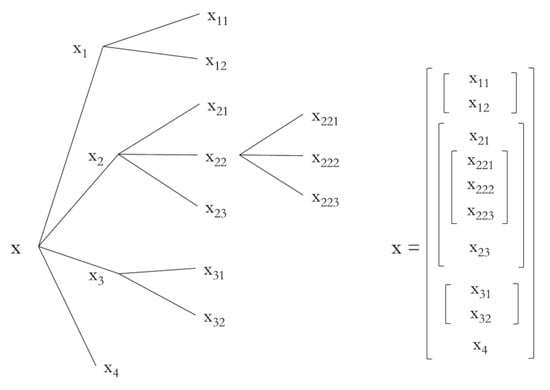
Figure 3.
Same fuzzy signatures in vector form and tree structure (own illustration).
Be the structural base vector is: , where sub-trees are:
The next points can clarify the advantage of fuzzy signatures, compared to other methods. First, it has to be mentioned that in most real-life problems regarding packaging, there is a wide range of uncertainty involved. This uncertainly includes the elements introduced by the necessary subjectivity of human definitions and criteria; the multitude of influencing factors, which cannot be explicitly included in the model due to the extreme complexity resulting from such over-dimensionalized formal structures; and by the non-deterministic effects that occur during the transportation of goods (and possibly, the empty packaging). All these point towards the use of a non-probabilistic type of mathematical model, eminently, a fuzzy system-based approach. Fuzzy models can deal with, among others, decision-making situations, where some of the data components are not completely or not at all known (as mentioned above, partly due to being subjective, ill-defined, and partly due to inherently non-deterministic features). There are other decision models, like decision trees, TOPSIS, etc., which all apply probabilistic and/or metric approaches that cannot be adequately utilized here, due to the very restrictive additivity of the probabilistic measure. It does not hold for other uncertainty measures, like the possibility measure closely connected with the fuzzy model [23], and due to the total lack of linear metric spaces, which are the starting assumption of the traditional decision approaches like TOPSIS and the related approaches [29,30].
Accepting the necessity of utilizing a fuzzy approach, the next interesting question must be asked, what depth of uncertainty modeling should be applied here? Fuzzy systems are based on the original definition of fuzzy sets given by Zadeh [25]. Soon, however, many generalizations of the idea were introduced, among others, the important abstract concept of L-fuzzy sets [31] and higher level uncertainty modeling such as Type 2 fuzzy sets (see, e.g., [32]) and intuitionistic fuzzy sets [33]. When establishing a model of a real-life application problem, it is always challenging to make a decision on the ”fineness” and ”depth” of the model, and in this case the degree of uncertainty involved in the model. While the latter two approaches unambiguously offer a much more flexible ”uncertain uncertainty” degree-based techniques, at the first step of attempting an acceptably adequate description of the decision process, in the simpler ”single level uncertainty” modeling of fuzzy sets, and the extended L-fuzzy set concept seems to be sufficient. It is especially so because it is obviously extremely difficult to describe the subjective elements of decision processes on logistics more precisely than simply by estimating the degrees of membership.
There are several very straightforward extensions of the original fuzzy set concept, which fall within the broader definition of L-fuzzy sets, such as the vectorial fuzzy sets [34]. However, this latter also falls short of properly reflecting the non-metric nature of the problem at hand. A further step towards more flexible multicomponent uncertain models, fuzzy signatures, was proposed in [35], and later, a special, but practically rather important class of fuzzy signatures was shown to be L-fuzzy [36].
Fuzzy signatures (FSigs) can be considered to be special extended multicomponent fuzzy data, where some of the components may be interrelated in the sense that a sub-group of variables determines a feature on a higher level. Such sub-groups may have sub-sub-groups, etc., this allows for the arbitrary local compression of the uncertain information available.
Aggregation of Fuzzy Signatures
For decision specialists, it goes without saying that the structure of fuzzy signatures may vary from observation to observation, which is why some kind of modifying operation must be included in the structure. Thereby, the aggregation operations result in a single fuzzy value from a set of other fuzzy values and must satisfy a set of axioms. The maximum, minimum and arithmetic mean are the most common operators [35]. Thus, the fuzzy value of a parent node can be obtained by aggregating the values of its sub-tree.
Based on the evaluation of the opinions of five packaging specialists, the chosen aggregation type for this study was the weighted arithmetic mean. Two of them came from academia, packaging professors; and three of them came from the industry (transportation packaging engineer, a packaging supply chain manager at a multinational company and a production manager at a packaging manufacturing company). The arithmetic weighted average (AWA) of n values can be used if the ”root” (the internal node) has n children nodes (which have their own assigned membership functions or are outputs of other aggregations—here, the membership degrees are denoted by the letters μ) with predefined values for weights (denoted by wi), and subsequently the output of the aggregation can be calculated. The reason for using the arithmetic mean at this point is that, following the evaluations of the packaging experts, the individual features and the further components of these features seem to be of at least comparable importance, which may be expressed in the same weighted mode, as follows:
where µ1, µ2, …, µn is the element of signature, and w1, w2, …, wn is the non-negative weight.
Nevertheless, in further studies, alternatives for the aggregations may be taken into consideration. If a statistically significant pool of real data is available, it may be reasonable to fit the aggregations, especially the values of the weights, by applying some kind of statistical probes, like it was done in [36].
3. Methods (Framework for Packaging Decision)
In this Section, the structure of three different fuzzy signatures (FSig) and the fuzzy rules among them are explained and presented for this study. To model the packaging decision problem, a three-dimensional signature structure (S1, S2, S3) was proposed, including tree and aggregation that operates in the intermediate nodes. The reason for this selection is that the components in these sets are interrelated in the sense that the sub-group of variables determines a feature at a higher level. Figure 4 shows the main aspects examined in the fuzzy signature model for this study. The features of these signatures will be explained in detail later.
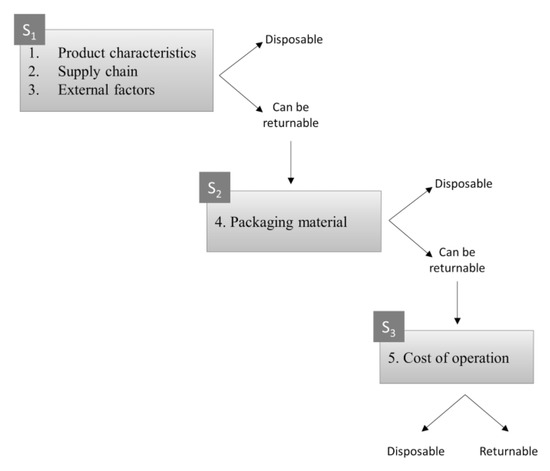
Figure 4.
Main aspects examined in the cascaded hierarchical fuzzy signature model for this study (own illustration).
Defining the appropriate aggregation operators is a very important issue when modeling with fuzzy signatures. With the introduction of some weighted (asymmetric) aggregation, additional expertise in the area has to be taken into account [37,38]. Therefore, for this study, these interrelations are based on the opinion of a panel of five packaging experts. Their common decision was the determination of the weights (wi) for both leaves (with membership functions, µi) and intermediate nodes (with aggregations, ai).
The model is a hierarchical cascaded one that goes from a signature level to a signature level built on each other, while at a given level, a decision must be made about one-way or potentially returnable packaging. The first signature can be described (S1), with the components of:
- Characteristics of the product to be packaged;
- Characteristics of the supply chain; and,
- External factors.
After considering the first three aspects, an additional aspect was examined at the second level signature (S2):
- 4.
- Characteristics of the packaging material and device.
In the third signature (S3), the cost factors are added in order to get the final result.
- 5.
- Operation cost of given packaging system.
The relation among the three signatures is determined by the following rules:
where Si are the three-dimensional fuzzy sets. Logically, the above rule base can be extended to function with further fuzzy signatures using the generalization of the rules. Furthermore, the readers of this paper have to consider that the structure of the observation does not necessarily correspond exactly to the fundamental structure of the base rules, but it can often be obtained by removing or replacing some sub-trees or simple leaves. This indicates that some information might be missing from the observation.
| R: | S1: | ifµS1 ≥ 0.5 then check S2 else one-way |
| S2: | ifµS1 ≥ 0.5 and µS2 ≥ 0.5 then check S3 else one-way | |
| S3: | ifµS1 ≥ 0.5 and µS2 ≥ 0.5 and µS3 ≥ 0.5 then returnable else one-way. |
All the leaves of the tree assume their values (µi) from the interval [0,1]. (Figure 5 presents the tree-structure of the fuzzy signatures for this study.) The values belonging to the intermediate nodes are calculated by respective functions specified to each leaf according to the logistics meaning and role. The relations among the individual descendants on the same level are determined with respective aggregations. (For more information, a numerical example is shown in Appendix C). The final goal of the model was to support the decision whether a disposable (one-way) or returnable packaging system should be used. When the final value created by the aggregation in the root (a0) is close to 0, it should rather be one-way, if the result of a0 is close to 1, the packaging should be returnable.
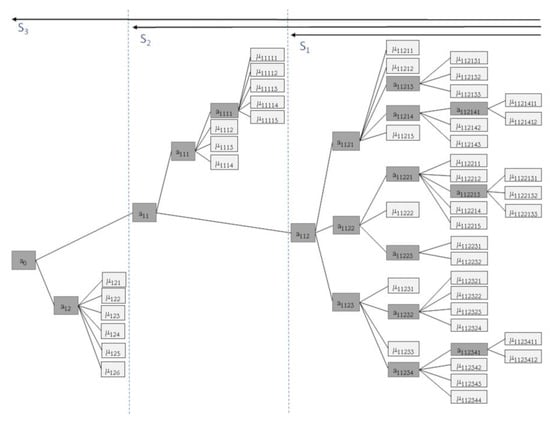
Figure 5.
Tree-structure of the fuzzy signatures for this study (own illustration).
Finally, examples based on real-life goods packaging technologies are used to confirm the values and the type of aggregations used in this rather complex fuzzy signature.
3.1. Aggregation Operators
Then, based on the panel discussions of packaging experts, the aggregations were weighted as a type of arithmetic mean. The reason for this type is that the components of the given characteristics and features have a similar effect. Naturally, their importance is analogous. These can be expressed by weights with the same or similar intensity. Tables 2–6 show these magnitudes.
3.2. Main Aspects and the Weights
In this Section, the parent and child nodes are described. The values of the weights for both parent and child nodes have been determined on a simple linear scale by a panel of experts (as mentioned earlier, both from academia and industry). The results of the survey can be found in Appendix A. First, the authors created a possible list of aspects. It was discussed and the scale was determined together with the experts in the framework of a moderated panel conversation. The scale values (weights) thus determined are the results of a common agreement of the experts. For further research, for example, the Guilford method (pairwise comparison of complex systems) could be applied to determine the weights more exactly, or a statistical analysis of a larger pool of available data may help find appropriate weights, but it is important to emphasize that the accurate determination of the weights is not the goal of this proposed model. Rather, the emphasis is on the methodology, which is generally applicable to any product or packaging device, while weights may largely depend on the actual problem. The weights can be re-established for different projects; thus, increasing the flexibility of the model. Table 1 presents the weights of aggregation operators (the weights of the roots of the different sub-trees which are not further defined in the following Section but are essential for the calculations). ID represents the position (index) of the aspect (as a leaf or aggregation) in the fuzzy signature.

Table 1.
Weights of the aggregation operators in the model for this study.
3.3. Product Characteristics
Table 2 presents the weights of product characteristics for the fuzzy aggregation of this study. This specification presents those technical details of designing, which are concerned with the right packaging for the proper product. It must be highlighted here that batch size and turnover are very important aspects. Other parameters such as geometrical characteristics (shape), product size and weight should also be considered. As it can be seen in Table 2, the sensitivity of goods for physical, biological, and chemical circumstances as well as its value play an important role. The mechanical and climate conditions in this group were separated due to those different effects on the product-packaging system.

Table 2.
Weights of the components of product characteristics and their respective sub-trees.
3.4. Supply Chain (Logistics) Characteristics
Table 3 presents the weights of logistics and supply chain aspects of designing the right packaging solution for a given product. Transportation as a significant part of SC activities represents a main part; within this category, the model differentiates transportation distance, as well as the volume of goods delivered at the same time. The environmental circumstances are also important from a packaging point of view, such as temperature, vibration, and relative humidity. The decision may be influenced by the quality of infrastructure and the modality (transportation mode). In addition, the transportation and material handling (including warehousing, loading, unloading and transshipments) and IT support should also be considered. Since the complexity of the task is usually growing with the number of stakeholders, the organizational level of truckloads (FTL—full truckload/LTL—less than truckload) can also play an important role when deciding about returnable packaging.

Table 3.
Weights of the components of the supply chain characteristics and their respective sub-trees.
3.5. External Factors
Table 4 presents those external factors that influence the decision in an indirect way, such as the regulations, legal aspects and external conditions. The cooperation level may fundamentally determine the possibility of applying returnable packaging systems. Environmental effects are not always emphasized enough in corporate practice, but the authors find it necessary to build them into the model. Furthermore, these are all packaging-related, like the quantity of raw materials and energy consumed in the production, the CO2 emissions of return transports, effective vehicle utilization and the pool size, which is the necessary amount of returnable packaging devices circulating in the system.

Table 4.
Weights of the components of the external factors and their respective sub-trees.
3.6. Packaging Material and Device
After the results of the first signature, if the model shows that returnable packaging can be used, an additional aspect should be considered. In the second signature, the planning aspects and characteristics of packaging material are examined. With respect to used material, robustness represents the quality and quantity of the material used in order to make the packaging strong enough. Availability is connected to the procurement options of the material, while recyclability and reusability play an important role within the supply chain after the material is used. Tare weight, collapsibility and packaging fill rate determine the capacity usage, during transport and especially in return transport. The possible number of uses represents the technical suitability for reuse. The weights of the weighted arithmetic mean aggregations in the second fuzzy signature can be seen in Table 5.

Table 5.
Weights of the components of packaging material and their respective sub-tree.
3.7. Cost of Operation
Cost aspects in corporate decisions obviously have major importance; nonetheless, we consider them merely in the third signature. The reason for this is the different cost structure of a one-way and returnable packaging system. There are certain cost components that only occur in the case of returnable packaging solution (i.e., the cleaning and maintenance or administration). At this point, the results already justified the opportunity for returnable packaging, and according to the fuzzy rules in the model, cost will be only examined in this case. The weights in the third fuzzy signature can be seen in Table 6. Here, it must be noted that according to the experts’ opinion, all these features have similar importance.

Table 6.
Aggregation weights of components of operation cost aspects.
It is recognizable that all membership functions are variants of the triangular or trapezoidal membership functions (Figure 6) due to the linear variables. The types of membership functions for the leaves in this study can be found in Appendix B.
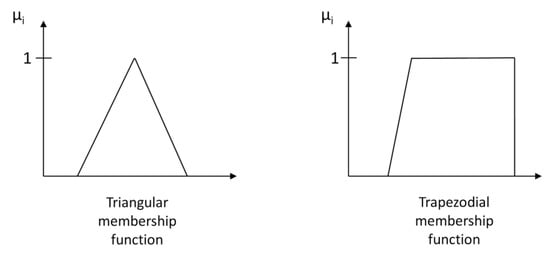
Figure 6.
Membership functions shapes applied in this study (own illustration).
4. Algorithm of Program
A program was written (in C++), so that it calculates the resulting value assigned to the root (between 0…1) for each possible packaging alternative. Logically, if the result is close to 0 (say, less than 0.5), then this means it should rather be single-trip packaging. When it is close to 1 (>0.5), it should be reusable. The program works with a text-file. Tree-graph files represent the packaging, and the software can determine the final values for these files. The input file-type is expressed as follows:
- It must be an aggregation if the line is not beginning with a hyphen. This is a root node. Only one root node is permitted. The line starts with “a”—the letter followed by the identity number of the node, an under-score character, and the aggregation type (in this case AWA), respectively. Naturally, the weight parameter is only permitted when the node has an AWA-type parent.
- Every other line must begin with hyphens. At the root node, there are no hyphens. When a line actually begins with n number of hyphens, its child should start with n+1 number of hyphens. Characters following the hyphens:
- ○
- Aggregation is “a” with the identity number for the given node, underscore, AWA, space character, “weight_”, and a float number.
- ○
- Fuzzy membership function is “u” (like μ) with the identity number for the node, coordinates, the “question” to answer the function, and the weight parameter (in case of AWA aggregation). Coordinates for instance are:
- 0H328.56 → x = 328.56, y = 0.00
- 1H328.56 → x = 328.56, y = 1.00
- FH328.56 → x = 328.56, y = 0.50
A sample input file syntax is shown here below:
- ⁃
- a0_AWA
- ⁃
- -a1_AWA weight_3.0
- ⁃
- --u11 0H50.0 1H25000.0 ?20000.0 weight_9.0
- ⁃
- --u12 0H0.0 1H300.0 ?120.0 weight_9.0
- ⁃
- --a13_AWA weight_7.0
- ⁃
- ---u131 0H0.0 1H2.0 0H10.0 ?1.2 weight_4.0
- ⁃
- ---u132 0H0.0 1H1.0 0H10.0 ?2.2 weight_1.0
- ⁃
- ---u133 0H0.0 1H1000.0 1H2000.0 0H3000.0 ?500.0 weight_1.0
5. Results and Discussion
In this Section, two operative examples (one for an industrial and one for customer packaging) are shown in order to illustrate the applicability of the proposed model.
5.1. Case Study 1
For industrial transport packaging, an example of automotive engines (CKD—complete knock down) was examined. These products are sensitive and need a high level of protection while being transported from Europe to India and China, which is why wooden crates are mainly used for storage and transport. This can be seen in Figure 7. The columns of the crates can be collapsed when empty in order to save space when they are returned. The components of the entire unit consist of the wooden crate (1 pc, 221.73 kg), etiquette label (1 pc, 0.05 kg), unit load (polyethylene) cap (1 pc, 0.78 kg), engine unit VCI caps (9 pcs, 1.88 kg), lag screws (18 pcs, 1.84 kg), cable ties (9 pcs, 0.60 kg), angle irons (9 pcs, 5.85 kg) and cushion sponges (9 pcs, 3.67 kg), with a total tare weight of 236 kg. The geometrical size of the unit is 2260 × 1930 × 863 mm.
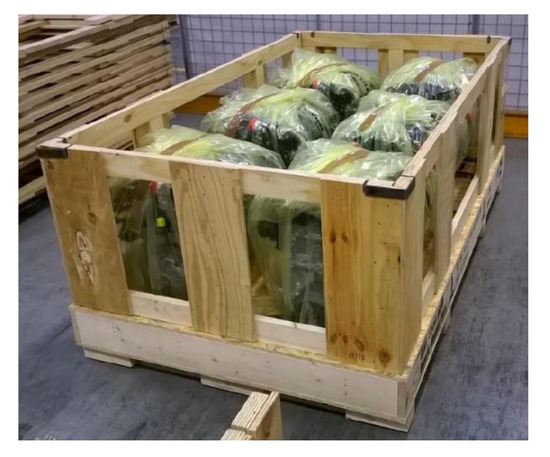
Figure 7.
Returnable wood crate packaging used for overseas complete knock down (CKD) transport (own illustration).
For this example, the program calculates every sub-tree according to the fuzzy signature. The values of all leaves (µi) are fuzzy membership degrees calculated from membership functions and all values of the parents are calculated according to aggregation and the respective weights. The fuzzy values and the calculated aggregation values can be found in Appendix B. Packaging experts describe the characteristics of the engine crate as it is presented in Section 3.1 and Section 3.2. The result of the FSig (fuzzy signature) was calculated by the aggregations on the values in Table 2, Table 3 and Table 4. The final result of a0 of S3 in this case is 0.6103 > 0.5.
According to the result calculated in the model, the packaging system should be returnable. This is in accordance with the practice of the automotive engine manufacturer providing data for this case study. Some of the sub-sub-models had their results µ below 0.5 (this can be seen in Appendix B), which should induce one-way (single trip/disposable) packaging, but the other two sub-models can compensate for these values, so the aggregated final membership degree and the final result all suggest reusable packaging.
5.2. Case Study 2
The packaging problem considered here is a well known customer packaging problem: the PET (polyethylene terephthalate) bottle with a volume capacity of 0.5l shown in Figure 8. The methodology is the same as in in case 1 with wooden crates and this is the reason of why the authors chose this consumer packaging for a second example. The components of the consumer packaging are the following: PET bottle body (10.3 g), HDPE (high-density polyethylene) cap (5.10 g), and PE (polyethylene) etiquette label (0.01 g), with a total weight of 0.01541 kg (15.41 g).
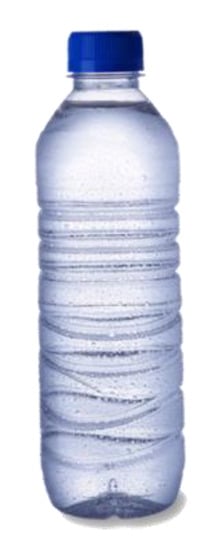
Figure 8.
PET (polyethylene terephthalate) bottle for mineral water (own illustration).
The FSig of the model, as described above, calculates the result. The result, at the root of S1 (a112), showed a value of 0.519534 > 0.5, but the results of S2 was a11 = 0.481103 < 0.5, which means that the calculation stopped here, because the packaging system should be disposable. Although reusable plastic bottles exist and are still used today in some places, according to the aspects considered in the model, this packaging should be disposable, as it is generally and widely used. Here, it has to be mentioned that reusable PET bottles had issues concerning the environmental consequences.
5.3. Limitations
The readers of this paper have to consider that product characteristics and supply chain characteristics may be more complex, so an unwanted simplification can pose a significant risk to a complex decision; often, it is almost impossible to estimate the full effect of a combination of factors. Some interrelations, i.e., between packaging and supply chain, cannot be captured perfectly by the current model. For instance, if a heavy package can be handled by automatic equipment then this interrelation may be more efficient in the aspect of the supply chain. However, these kinds of interrelations can be incorporated into an extended model. Also, expertise from other areas (not only packaging) can be taken into consideration for more accurate results.
Here, it also has to be noted that in the third signature, the cost of packaging obviously depends on the cost of the packaging itself and its impact on the entire supply chain (i.e., to enable transport and logistics efficiency), and its capability to minimize packaging waste. Therefore, these factors are considered in an integrated manner, as it is the sum of these factors that determines the total cost of packaging in S3.
Compared to the other methods, one of the main advantages of fuzzy signatures is that the necessary subjectivity of human definitions and criteria may be modeled. In this context, obviously a non-probabilistic type of mathematical model is required because of the "loose" mathematical conditions that apply. Other decision models (like decision trees, TOPSIS, etc.) all apply probabilistic and/or metric approaches, which cannot be adequately utilized here, due to the very restrictive additivity of the probabilistic measure and because of the total lack of linear metric spaces. Any approach that assumes the presence of an additive (probabilistic) measure will inadvertently lead to a distorted representation of the original packaging problem.
An important feature of FSigs is the presence of (arbitrary) fuzzy aggregations in all internal nodes representing the tree graph of the membership degree groups and sub-groups of the FSig (including the root). These aggregations in the nodes must be chosen so that they are most fitting to the internal connections of the sub-degrees appearing on the leaves of the sub-trees rooted in the given node. Due to the freedom in determining the aggregation that most fit independently in every internal node, the inadequacy of using (Euclidean or other) metric spaces and concepts of distance, as in many other decision systems, is overcome here. Even fuzzy approaches with restricted classes of aggregations, such as fuzzy production rule bases (where a combination of t-norms and co-norms are applied) do not offer this flexibility. FSigs, in contrast, may apply an arbitrary combination of t-norms, co-norms, and symmetrical and asymmetrical mean type aggregations.
6. Conclusions
The fuzzy model developed for the decision-making process, comparing returnable and one-way packaging systems, was presented in the case using industrial and consumer packaging samples. The technique of the model used a fuzzy signature algorithm based on the packaging characteristics offered by packaging experts using membership functions on aggregation and weighted values. In both presented case studies, the use of fuzzy signature models led to overall membership degrees supporting the use of the type of packaging that are in accordance with experts’ domain knowledge and confirm the real-life applications and conditions.
In conclusion, it can be stated that the final model may be applicable as a decision support method for packaging decision makers and engineers to help evaluate the packaging designing process in a broader view beyond the cost-based mechanism. In order for the presented method in this study to become a decision support tool, numerous case studies have to be conducted in the future. Further research is ongoing, taking steps towards refining the model, especially separating customer and industrial packaging, and modeling the environmental issues in more detail. The authors want to present these results in the following paper, after varied packaging systems are evaluated in different kinds of industrial sectors.
Author Contributions
K.V. and P.B. designed the research and conducted the panel discussion and experiments; L.T.K. and P.F. developed the fuzzy signatures model. K.V. analyzed the data and wrote the original draft; P.F. and L.T.K reviewed and finalized the draft. This research project was conducted under the supervision of P.B. All authors have read and agreed to the published version of the manuscript.
Funding
The research was funded by the European Union and the Hungarian Government from the project “Intensification of the activities of HU-MATHS-IN - Hungarian Service Network of Mathematics for Industry and Innovation”, under grant number EFOP-3.6.2-16-2017-00015 and by the National Research, Development and Innovation Office (NKFIH), grant number K124055.
Conflicts of Interest
The authors declare no conflict of interest.
Appendix A

Table A1.
Survey, where ‘X’ represents the consensus of five packaging experts.
Table A1.
Survey, where ‘X’ represents the consensus of five packaging experts.
| Not Important | Very Important | |||||||||||
|---|---|---|---|---|---|---|---|---|---|---|---|---|
| 1. Product characteristics | 1 | 2 | X | 4 | 5 | 6 | 7 | 8 | 9 | 10 | ||
| 1.1 Batch size | 1 | 2 | 3 | 4 | 5 | 6 | 7 | 8 | X | 10 | ||
| 1.2 Turnover | 1 | 2 | 3 | 4 | 5 | 6 | 7 | 8 | X | 10 | ||
| 1.3 Geometrical characteristics | 1 | 2 | 3 | 4 | 5 | 6 | X | 8 | 9 | 10 | ||
| 1.3.1 Shape | 1 | 2 | 3 | X | 5 | 6 | 7 | 8 | 9 | 10 | ||
| 1.3.2 Size | X | 2 | 3 | 4 | 5 | 6 | 7 | 8 | 9 | 10 | ||
| 1.3.3 Weight | X | 2 | 3 | 4 | 5 | 6 | 7 | 8 | 9 | 10 | ||
| 1.4 Sensitivity | 1 | X | 3 | 4 | 5 | 6 | 7 | 8 | 9 | 10 | ||
| 1.4.1 Physical | 1 | 2 | 3 | 4 | 5 | X | 7 | 8 | 9 | 10 | ||
| 1.4.1.1 Mechanical | 1 | 2 | 3 | 4 | 5 | X | 7 | 8 | 9 | 10 | ||
| 1.4.1.2 Climate | 1 | 2 | 3 | X | 5 | 6 | 7 | 8 | 9 | 10 | ||
| 1.4.2 Biological | 1 | 2 | X | 4 | 5 | 6 | 7 | 8 | 9 | 10 | ||
| 1.4.3 Chemical | 1 | X | 3 | 4 | 5 | 6 | 7 | 8 | 9 | 10 | ||
| 1.5 Value | 1 | X | 3 | 4 | 5 | 6 | 7 | 8 | 9 | 10 | ||
| 2. Supply chain characteristics | 1 | 2 | 3 | 4 | 5 | 6 | 7 | 8 | X | 10 | ||
| 2.1 Transportation | 1 | 2 | 3 | 4 | 5 | 6 | 7 | X | 9 | 10 | ||
| 2.1.1 Distance | 1 | 2 | 3 | 4 | 5 | 6 | 7 | X | 9 | 10 | ||
| 2.1.2 Volume | 1 | 2 | 3 | 4 | 5 | 6 | X | 8 | 9 | 10 | ||
| 2.1.3 Environmental impacts | 1 | 2 | 3 | 4 | X | 6 | 7 | 8 | 9 | 10 | ||
| 2.1.3.1 Temperature | 1 | 2 | 3 | X | 5 | 6 | 7 | 8 | 9 | 10 | ||
| 2.1.3.2 Vibration | 1 | 2 | X | 4 | 5 | 6 | 7 | 8 | 9 | 10 | ||
| 2.1.3.3 Humidity | 1 | X | 3 | 4 | 5 | 6 | 7 | 8 | 9 | 10 | ||
| 2.1.4 Infrastructure | 1 | 2 | X | 4 | 5 | 6 | 7 | 8 | 9 | 10 | ||
| 2.1.5 Modality | X | 2 | 3 | 4 | 5 | 6 | 7 | 8 | 9 | 10 | ||
| 2.2 IT support | 1 | 2 | 3 | 4 | 5 | 6 | X | 8 | 9 | 10 | ||
| 2.3 Material handling | 1 | X | 3 | 4 | 5 | 6 | 7 | 8 | 9 | 10 | ||
| 2.3.1 Transshipment | 1 | 2 | 3 | 4 | 5 | 6 | 7 | X | 9 | 10 | ||
| 2.3.2 FTL/LTL | 1 | X | 3 | 4 | 5 | 6 | 7 | 8 | 9 | 10 | ||
| 3. External factors | 1 | X | 3 | 4 | 5 | 6 | 7 | 8 | 9 | 10 | ||
| 3.1 Cooperation | 1 | 2 | 3 | 4 | 5 | 6 | 7 | X | 9 | 10 | ||
| 3.2 Regulations | 1 | 2 | X | 4 | 5 | 6 | 7 | 8 | 9 | 10 | ||
| 3.2.1 Environmental | 1 | X | 3 | 4 | 5 | 6 | 7 | 8 | 9 | 10 | ||
| 3.2.2 Health | 1 | X | 3 | 4 | 5 | 6 | 7 | 8 | 9 | 10 | ||
| 3.2.3 Benefits | 1 | X | 3 | 4 | 5 | 6 | 7 | 8 | 9 | 10 | ||
| 3.2.4 Standards | 1 | X | 3 | 4 | 5 | 6 | 7 | 8 | 9 | 10 | ||
| 3.3 Legal | 1 | X | 3 | 4 | 5 | 6 | 7 | 8 | 9 | 10 | ||
| 3.4 Environmental effects | 1 | X | 3 | 4 | 5 | 6 | 7 | 8 | 9 | 10 | ||
| 3.4.1 Production related | 1 | 2 | 3 | 4 | 5 | 6 | 7 | 8 | 9 | X | ||
| 3.4.1.1 Raw material | 1 | 2 | 3 | 4 | 5 | 6 | 7 | 8 | 9 | X | ||
| 3.4.1.2 Energy | 1 | 2 | 3 | 4 | 5 | 6 | 7 | X | 9 | 10 | ||
| 3.4.2 CO2 emission | 1 | 2 | 3 | 4 | 5 | 6 | 7 | X | 9 | 10 | ||
| 3.4.3 Pool size | 1 | 2 | 3 | 4 | 5 | 6 | X | 8 | 9 | 10 | ||
| 3.4.5 Vehicle utilization | 1 | 2 | 3 | 4 | X | 6 | 7 | 8 | 9 | 10 | ||
| 4. Packaging material | 1 | 2 | 3 | 4 | 5 | 6 | 7 | X | 9 | 10 | ||
| 4.1 Used material | 1 | 2 | 3 | 4 | 5 | 6 | 7 | 8 | X | 10 | ||
| 4.1.1 Robustness | 1 | 2 | 3 | 4 | 5 | 6 | 7 | X | 9 | 10 | ||
| 4.1.2 Availability | 1 | 2 | 3 | 4 | 5 | 6 | X | 8 | 9 | 10 | ||
| 4.1.3 Recyclability | 1 | 2 | 3 | X | 5 | 6 | 7 | 8 | 9 | 10 | ||
| 4.1.4 Reusability | 1 | 2 | 3 | X | 5 | 6 | 7 | 8 | 9 | 10 | ||
| 4.1.5 Tare weight | 1 | X | 3 | 4 | 5 | 6 | 7 | 8 | 9 | 10 | ||
| 4.2 Packaging fill rate | 1 | 2 | 3 | 4 | 5 | 6 | 7 | X | 9 | 10 | ||
| 4.3 Number of uses | 1 | 2 | 3 | 4 | 5 | 6 | X | 8 | 9 | 10 | ||
| 4.4 Collapsibility | 1 | 2 | 3 | 4 | 5 | 6 | X | 8 | 9 | 10 | ||
| 5. Cost of operation | 1 | 2 | 3 | 4 | 5 | 6 | 7 | X | 9 | 10 | ||
| 5.1 Packaging material | 1 | 2 | 3 | 4 | X | 6 | 7 | 8 | 9 | 10 | ||
| 5.2 Disposal | 1 | 2 | 3 | 4 | X | 6 | 7 | 8 | 9 | 10 | ||
| 5.3 Capital asset | 1 | 2 | 3 | 4 | X | 6 | 7 | 8 | 9 | 10 | ||
| 5.4 Cleaning and maintenance | 1 | 2 | 3 | 4 | X | 6 | 7 | 8 | 9 | 10 | ||
| 5.5 Storage | 1 | 2 | 3 | 4 | X | 6 | 7 | 8 | 9 | 10 | ||
| 5.6 Administration | 1 | 2 | 3 | 4 | X | 6 | 7 | 8 | 9 | 10 | ||
Appendix B

Table A2.
Type and value of membership function for leaves; calculated values at aggregation nodes.
Table A2.
Type and value of membership function for leaves; calculated values at aggregation nodes.
| Type of Membership Function for Component | Wooden Crate | PET Bottle | ||
|---|---|---|---|---|
| Membership Value | Calculated Value by Aggregation | Membership Value | Calculated Value by Aggregation | |
| Product characteristics (a1121) | 0.656461 | 0.454869 | ||
| Batch size (µ11211), Trapezoidal | 0.799599 | 1 | ||
| Turnover (µ11212), Trapezoidal | 0.4 | 0.2 | ||
| Geometrical characteristics (a11213) | 0.627778 | 0.00116717 | ||
| Shape (µ112131), Triangular | 0.6 | 0.001 | ||
| Size (µ112132), Triangular | 0.866667 | 0.003 | ||
| Weight (µ112133), Trapezoidal | 0.5 | 0.000003 | ||
| Sensitivity (a11214) | 0.923273 | 0.191515 | ||
| Physical (a112141) | 0.922667 | 0.351111 | ||
| Mechanical (µ1121411), Trapezoidal | 0.977778 | 0.518519 | ||
| Climate (µ1121412), Triangular | 0.84 | 0.1 | ||
| Biological (µ112142), Triangular | 0.9 | 0 | ||
| Chemical (µ112143), Triangular | 0.96 | 0 | ||
| Value (µ11215), Trapezoidal | 1 | 0 | ||
| Supply chain characteristics (a1122) | 0.587906 | 0.579394 | ||
| Transportation (a11221) | 0.3093 | 0.82407 | ||
| Distance (µ112211), Triangular | 0.1 | 0.98 | ||
| Volume (µ112212), Trapezoidal | 0.1 | 0.9 | ||
| Environmental impacts (a112213) | 0.724638 | 0.327536 | ||
| Temperature (µ1122131), Trapezoidal | 0.630435 | 0.586957 | ||
| Vibration (µ1122132), Triangular | 0.8 | 0.2 | ||
| Humidity (µ1122133), Triangular | 0.8 | 0 | ||
| Infrastructure (µ112214), Triangular | 0.6 | 1 | ||
| Modality (µ112215), Trapezoidal | 0.5 | 1 | ||
| IT support (µ11222), Triangular | 0.8 | 0.4 | ||
| Material handling (a11223) | 0.96 | 0.228571 | ||
| Transshipment (µ112231), Trapezoidal | 1 | 0.285714 | ||
| FTL/LTL (µ112232), Triangular | 0.8 | 0 | ||
| External factors (a1123) | 0.632284 | 0.347161 | ||
| Cooperation (µ11231), Triangular | 0.6 | 0.2 | ||
| Regulations (a11232) | 0.575 | 0.533333 | ||
| Environmental (µ112321), Triangular | 0.8 | 0.6 | ||
| Health (µ112322), Triangular | 0.5 | 0.333333 | ||
| Benefits (µ112323), Triangular | 0.6 | 0.4 | ||
| Standards (µ112324), Triangular | 0.4 | 0.8 | ||
| Legal (µ11233), Triangular | 0.575 | 0.4 | ||
| Environmental effects (a11234) | 0.87963 | 0.603704 | ||
| Production related (a112341) | 0.888889 | 0.511111 | ||
| Raw material (µ1123411), Triangular | 0.8 | 0.6 | ||
| Energy (µ1123412), Triangular | 1 | 0.4 | ||
| CO2 emission (µ112342), Trapezoidal | 1 | 1 | ||
| Pool size (µ112343), Trapezoidal | 1 | 0.285714 | ||
| Vehicle utilized. (µ112344), Triangular | 0.5 | 0.6 | ||
| Packaging material (a111) | 0.842069 | 0.481103 | ||
| Used material (a1111) | 0.69 | 0.344 | ||
| Robustness (µ11111), Triangular | 1 | 0.8 | ||
| Availability (µ11112), Trapezoidal | 0.75 | 0 | ||
| Recyclability (µ11113), Triangular | 0.6 | 0 | ||
| Reusability (µ11114), Triangular | 0.25 | 0.5 | ||
| Tare weight (µ11115), Trapezoidal | 0.3 | 0.1 | ||
| Packaging fill rate (µ1112), Triangular | 0.7 | 0.9 | ||
| Number of uses (µ1113), Trapezoidal | 1 | 0.7 | ||
| Collapsibility (µ1114), Trapezoidal | 1 | 0 | ||
| Cost of operation (a12) | 0.533333 | - | ||
| Packaging material (µ121), Triangular | 0.6 | - | ||
| Disposal (µ122), Triangular | 0.8 | - | ||
| Capital asset (µ123), Triangular | 0.2 | - | ||
| Cleaning and maintenance (µ124), Triangular | 0.6 | - | ||
| Storage (µ125), Triangular | 0.6 | - | ||
| Administration (µ126), Triangular | 0.4 | - | ||
Appendix C

Table A3.
Numerical example (calculation of the value of node no. 11221).
Table A3.
Numerical example (calculation of the value of node no. 11221).
| Input | Membership Function/Aggregation | Membership Value | Weights |
|---|---|---|---|
| µ112211 µ112212 a112213 µ112214 µ112215 | AWA | a11221 = 0.3093 | 8 |
| x112211 = 9000 | 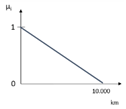 | µ112211 = 0.1 | 8 |
| x112212 = 10 | 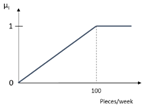 | µ112212 = 0.1 | 7 |
| µ1122131 µ1122132 µ1122133 | AWA | a112213 = 0.724638 | 5 |
| x1122131 = 40 | 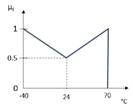 | µ1122131 = 0.630435 | 4 |
| x1122132 = 8 | 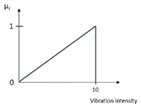 | µ1122132 = 0.8 | 3 |
| x1122133 = 80 | 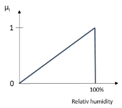 | µ1122133 = 0.8 | 2 |
| x112214 = 3 | 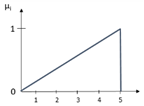 | µ112214 = 0.6 | 3 |
| x112215 = 4 | 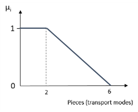 | µ112215 = 0.5 | 1 |
References
- Stock, J.R.; Lambert, D.M. Strategic Logistics Management; McGraw-Hill Higher Education: New York, NY, USA, 2001. [Google Scholar]
- Smith, A.D. Green Supply Chain Management and consumer sensitivity to greener and leaner options in the automotive industry. Int. J. Logist. Syst. Manag. 2012, 12, 1–31. [Google Scholar] [CrossRef]
- Na, B.; Sim, M.K.; Lee, W.J. Optimal Purchase Decision of Reusable Packaging in the Automotive Industry. Sustainability 2019, 11, 6579. [Google Scholar] [CrossRef]
- Böröcz, P.; Földesi, P. The application of the game theory onto the analysis of the decision theory of logistic packagings. Acta Tech. Jaurinensis 2008, 1, 259–268. Available online: https://acta.sze.hu/index.php/acta/article/view/119 (accessed on 21 October 2019).
- Dubiel, M. Costing Structure of Reusable Packaging Systems. Packag. Technol. Sci. 1996, 9, 237–254. [Google Scholar] [CrossRef]
- Yam, K.L. The Wiley Encyclopedia of Packaging Technology; John Wiley & Sons: New York, NY, USA, 2010; pp. 387–389. [Google Scholar] [CrossRef]
- European Parliament and the Council of the European Union. Directive (EU) 2018/852 of the European Parliament and of the Council of 30 May 2018 Amending Directive 94/62/EC on Packaging and Packaging Waste (Text with EEA Relevance). 2018. Available online: https://eur-lex.europa.eu/legal-content/EN/TXT/PDF/?uri=CELEX:32018L0852&from=EN (accessed on 17 August 2020).
- Nordin, N.; Selke, S. Social aspect of sustainable packaging. Packag. Technol. Sci. 2010, 23, 317–326. [Google Scholar] [CrossRef]
- Pålsson, H.; Finnsgård, C.; Wänström, C. Selection of packaging systems in supply chains from a sustainability perspective–the case of Volvo. Packag. Technol. Sci. 2013, 26, 289–310. [Google Scholar] [CrossRef]
- Sonneveld, K. The Role of Life Cycle Assessment as a Decision Support Tool for Packaging. Packag. Technol. Sci. 2000, 13, 55–61. [Google Scholar] [CrossRef]
- Early, C.; Kidman, T.; Menvielle, M.; Geyer, R.; McMullan, R. Informing packaging design decisions at Toyota motor sales using life cycle assessment and costing. J. Ind. Ecol. 2009, 13, 592–606. [Google Scholar] [CrossRef]
- Carrano, A.L.; Pazour, J.A.; Roy, D.; Thorn, B.K. Selection of pallet management strategies based on carbon emissions impact. Int. J. Prod. Econ. 2015, 164, 258–270. [Google Scholar] [CrossRef]
- Wohner, B.; Gabriel, V.H.; Krenn, B.; Krauter, V.; Tacker, M. Environmental and economic assessment of food-packaging systems with a focus on food waste. Case study on tomato ketchup. Sci. Total Environ. 2020, 738, 139846. [Google Scholar] [CrossRef]
- Niero, M.; Kalbar, P. Coupling material circularity indicators and life cycle based indicators: A proposal to advance the assessment of circular economy strategies at the product level. Resour. Conserv. Recycl. 2019, 140, 305–312. [Google Scholar] [CrossRef]
- Witt, C.E. Reusable distribution packaging saves money. Mater. Handl. Eng. 1993, 48, 14. [Google Scholar]
- Turki, S.; Didukh, S.; Sauvey, C.; Rezg, N. Optimization and Analysis of a Manufacturing–Remanufacturing–Transport–Warehousing System within a Closed-Loop Supply Chain. Sustainability 2017, 9, 561. [Google Scholar] [CrossRef]
- Grimes-Casey, H.G.; Seager, T.P.; Theis, T.L.; Powers, S.E. A game theory framework for cooperative management of refillable and disposable bottle life-cycles. J. Clean. Prod. 2007, 5, 1618–1627. [Google Scholar] [CrossRef]
- Mollenkopf, D.; Closs, D.; Twede, D.; Lee, S.; Burgess, G. Assessing the viability of reusable packaging: A relative cost approach. J. Bus. Logist. 2005, 26, 169–197. [Google Scholar] [CrossRef]
- Guo, D.; He, Y.; Wu, Y.; Xu, Q. Analysis of Supply Chain under Different Subsidy Policies of the Government. Sustainability 2016, 8, 1290. [Google Scholar] [CrossRef]
- Menesatti, P.; Canali, E.; Sperandio, G.; Burchi, G.; Devlin, G.; Costa, C. Cost and waste comparison of reusable and disposable shipping containers for cut flowers. Packag. Technol. Sci. 2012, 25, 203–215. [Google Scholar] [CrossRef]
- Braglia, M.; Frosolini, M.; Montanari, R. Fuzzy logic controller in a packaging plant. Packag. Technol. Sci. 2003, 16, 21–35. [Google Scholar] [CrossRef]
- Braglia, M. Designing a belt conveyor controller in a bottling plant using fuzzy logic and genetic algorithms. Packag. Technol. Sci. 2002, 14, 231–248. [Google Scholar] [CrossRef]
- Kang, Y.; Li, J. Green Rationality Evaluation of Degradable Packaging Based on LCA and Fuzzy AHP. In Proceedings of the IEEE 17Th International Conference on Industrial Engineering and Engineering Management, Xiamen, China, 29–31 October 2010; pp. 329–332. [Google Scholar] [CrossRef]
- Lozano-Olvera, G.; Ojeda-Benitez, S.; Castro, J.R.; Bravo-Zanoguera, M.; Rodriguez-Diaz, A. Identification of waste packaging profiles using fuzzy logic. Resour. Conserv. Recycl. 2008, 52, 1022–1030. [Google Scholar] [CrossRef]
- Zadeh, L.A. Fuzzy sets. Inf. Control. 1965, 8, 338–353. [Google Scholar] [CrossRef]
- Kóczy, L.T.; Tikk, D. Fuzzy Systems; Typotex: Budapest, Hungary, 2001. [Google Scholar]
- Tamás, K.; Kóczy, L.T. Inference in fuzzy signature based models. Acta Tech. Jaurinensis 2008, 1, 573–594. [Google Scholar]
- Dubois, D.; Prade, H. Possibility Theory, Probability Theory and Multiple-valued Logics: A Clarification. Ann. Math. Artif. Intell. 2001, 32, 35–66. [Google Scholar] [CrossRef]
- Hwang, C.L.; Lai, Y.J.; Liu, T.Y. A new approach for multiple objective decision making. Comput. Oper. Res. 1993, 20, 889–899. [Google Scholar] [CrossRef]
- Zavadskas, E.K.; Zakarevicius, A.; Antucheviciene, J. Evaluation of Ranking Accuracy in Multi-Criteria Decisions. Informatica 2006, 17, 601–618. [Google Scholar] [CrossRef]
- Gogen, J.A. L-fuzzy Sets. J. Math. Anal. Appl. 1967, 18, 145–174. [Google Scholar] [CrossRef]
- Karnik, N.N.; Mendel, J.M. Operations on Type-2 Fuzzy Sets. Fuzzy Sets Syst. 2001, 122, 327–348. [Google Scholar] [CrossRef]
- Atanassov, K. Intuitionistic Fuzzy Sets. Fuzzy Sets Syst. 1986, 20, 87–96. [Google Scholar] [CrossRef]
- Kóczy, L.T. Vectorial I-fuzzy set. In Approximate Reasoning in Decision Analysis; Gupta, M.M., Sanchez, E., Eds.; North-Holland Publishing Company: Amsterdam, The Netherlands; Oxford: New York, NY, USA, 1982; pp. 151–156. [Google Scholar]
- Kóczy, L.T.; Vámos, T.; Biró, G. Fuzzy signatures. In Proceedings of the Eurofuse-SIC’99, Budapest, Hungary, 25–28 May 1999. [Google Scholar]
- Kóczy, L.; Purvinis, O.; Susniene, D. Some considerations on data mining from questionnaires by constructing fuzzy signatures based on factor analysis. J. Intell. Fuzzy Syst. 2019, 36, 3739–3749. [Google Scholar] [CrossRef]
- Mendis, B.S.U.; Gedeon, T.D.; Kóczy, L.T. Investigation of aggregation in fuzzy signatures. In Proceedings of the 3rd International Conference on Computational Intelligence, Robotics and Autonomous Systems, Singapore, Singapore, 14 December 2005; Volume 406. [Google Scholar]
- Gedeon, T.D.; Wong, K.W.; Tikk, D. Constructing Hierarchical Fuzzy Rule Bases for Classification. In Proceedings of the 10th IEEE International Conference on Fuzzy Systems (FUZZ-IEEE 2001), Melbourne, Victoria, Australia, 2–5 December 2001; pp. 1388–1391. [Google Scholar]
© 2020 by the authors. Licensee MDPI, Basel, Switzerland. This article is an open access article distributed under the terms and conditions of the Creative Commons Attribution (CC BY) license (http://creativecommons.org/licenses/by/4.0/).